Have you come across a 1955 penny in your spare change and are curious whether it could be worth something? You’re in the right place!
In this guide, we’ll explore the value of the 1955 Wheat penny, dive into its history and design, and explain what makes certain coins more desirable to collectors. We’ll also take a closer look at the impact mint errors can have on a coin’s worth.
Let’s dig into the details of this fascinating Lincoln cent!
1955 Wheat Penny Value Overview
Here’s a look at how much a 1955 Wheat penny can be worth, depending on its mint mark and condition. All listed values are for coins graded Red unless stated otherwise:
| Mint Mark | MS63 | MS65 | MS67 |
|---|---|---|---|
| 1955 (No Mint Mark) | $9 | $22 | $850 |
| 1955 D | $8 | $20 | $575 |
| 1955 S | $5 | $18 | $150 |
And if you’re lucky enough to own a 1955 Proof Penny, here’s what you might expect:
| Proof Grade | PR63 | PR65 | PR67 |
|---|---|---|---|
| Red | $18 | $28 | $55 |
| Cameo | $22 | $55 | $150 |
| Deep Cameo | $80 | $275 | $700 |
*Note: These values apply to uncirculated coins with the Red (RD) designation, which indicates a bright coppery-red color. Coins with Red-Brown (RB) or Brown (BN) tones are generally less valuable.
History of the 1955 Wheat Penny
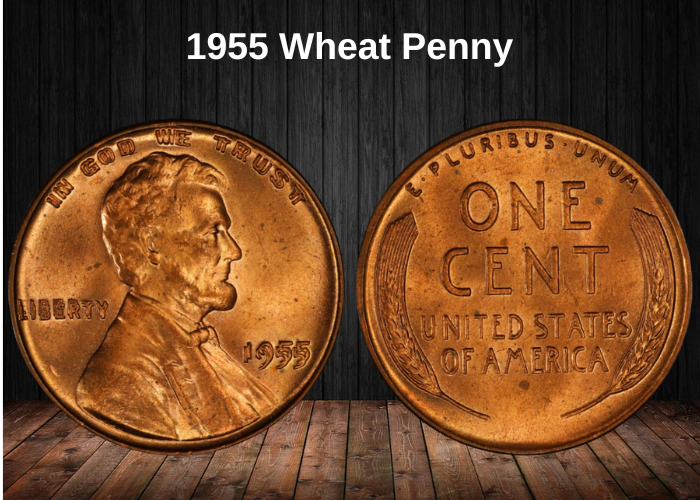
The 1955 Wheat penny is part of the long-running Lincoln cent series, a coin type first introduced in 1909 and still in circulation today. These coins are named after the prominent portrait of President Abraham Lincoln on the obverse (front) side.
The release of the Lincoln cent coincided with the 100th anniversary of Lincoln’s birth, making it a commemorative issue. It was also historically significant as the first U.S. coin to feature a real historical figure—before that, U.S. coins typically displayed allegorical images like Lady Liberty.
The nickname “Wheat penny” comes from the reverse (back) design, which features two curved stalks of durum wheat, one on each side of the coin’s edge. This design symbolized national prosperity and was used from 1909 until 1958.
Just four years after the 1955 issue, the reverse was replaced. In 1959, to celebrate Lincoln’s 150th birthday, the U.S. Mint introduced a new design showing the Lincoln Memorial in Washington, D.C., replacing the iconic wheat stalks.
Features of the 1955 Wheat Penny
Obverse of the 1955 Wheat Penny
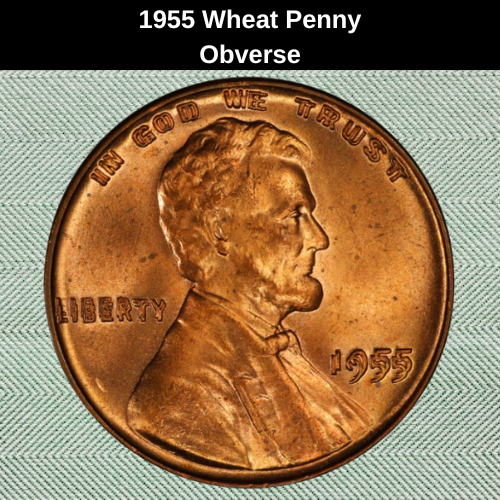
The obverse (or “heads” side) of the 1955 Wheat penny features the well-known profile portrait of President Abraham Lincoln, facing right. While the relief on 1955 coins is slightly higher than on earlier issues, the image remains essentially the same one used on modern pennies.
This iconic design was created by Victor David Brenner, a talented artist originally from the Russian Empire, in an area now part of Lithuania. After immigrating to the United States, Brenner furthered his studies in Paris and ultimately crafted over 120 medals and engravings during his career.
Despite this impressive body of work, Brenner is best remembered for his Lincoln portrait—though his name was initially absent from the coin. His proposed initials, placed prominently on the reverse, were criticized as too commercial. Due to public backlash over what some saw as inappropriate “advertising”, the U.S. Mint removed them entirely.
However, in 1918, Brenner’s initials were discreetly reinstated—this time on the obverse, just at the bottom of Lincoln’s shoulder. They remain there today for careful eyes to spot.
The upper rim of the coin bears the motto “IN GOD WE TRUST”, arching above Lincoln’s head. On the left side is the word “LIBERTY”, while the date (1955) is inscribed on the right.
If the coin was struck at the Denver or San Francisco mints, you’ll also see a small “D” or “S” mint mark just below the date.
Reverse of the 1955 Wheat Penny

The reverse design of the 1955 Wheat penny was also created by Victor David Brenner. Interestingly, it wasn’t his original submission—his first design featured a tree branch, but it was ultimately rejected for resembling contemporary French coinage too closely.
The final design showcases two stylized ears of durum wheat curving gracefully along the left and right edges of the coin. These wheat stalks act as a visual frame for the denomination, “ONE CENT,” which is boldly inscribed across two central lines.
Beneath the denomination appears the inscription “UNITED STATES OF AMERICA” in smaller font. At the very top of the reverse side is the Latin motto “E PLURIBUS UNUM,” meaning “Out of many, one.” This phrase reflects the foundational idea of the United States as a union of states coming together as one nation.
Other Features of the 1955 Wheat Penny
The 1955 Wheat pennies were struck in bronze, composed of 95% copper and 5% tin and zinc. Just seven years later, in 1962, tin was removed from the alloy to simplify the minting process.
Thanks to the high copper content, these coins can be found in a wide range of tones. Pennies with little to no handling retain a bright red copper appearance, while those exposed to air or frequent use gradually turn a reddish-brown or even a full brown color.
When it comes to collectible value, red coins are the most desirable. They’re followed by red-brown coins, and brown coins are generally the least valuable—assuming all other conditions (like grade) are equal.
To qualify as a particular color grade:
- A “red” penny must have 95% or more of its surface showing original red copper color.
- A “brown” penny must be at least 95% brown.
- Anything in between is considered “red and brown” (or RB).
Curious to dive deeper into color grading? Check out this helpful YouTube video by CoinOpp that explains it in detail.
1955 Wheat Penny Grading
The condition of a 1955 Wheat penny is a key factor in determining its value. Coins are graded on a scale that ranges from heavily worn and non-collectible to perfect mint condition.
Below is a breakdown of the most common coin grades:
| Grade | Description |
|---|---|
| 1 | Basal State-1 (Barely identifiable) |
| 2 | Fair |
| 3 | Very Fair |
| 4–6 | Good |
| 7–10 | Very Good |
| 12,15 | Fine |
| 20,30 | Very Fine |
| 40 | Extremely Fine |
| 50 | About Uncirculated |
| 60 | Mint State 60 (Basic uncirculated) |
| 65 | Mint State 65 (Gem uncirculated) |
| 70 | Mint State 70 (Perfect condition) |
🔍 Tip: To accurately determine your coin’s grade, it’s best to consult a professional grading guide or have it evaluated by an expert. Knowing the exact grade is essential to understanding its true value!
1955 Wheat Penny Value Guides
1955 No Mint Mark Wheat Penny Value
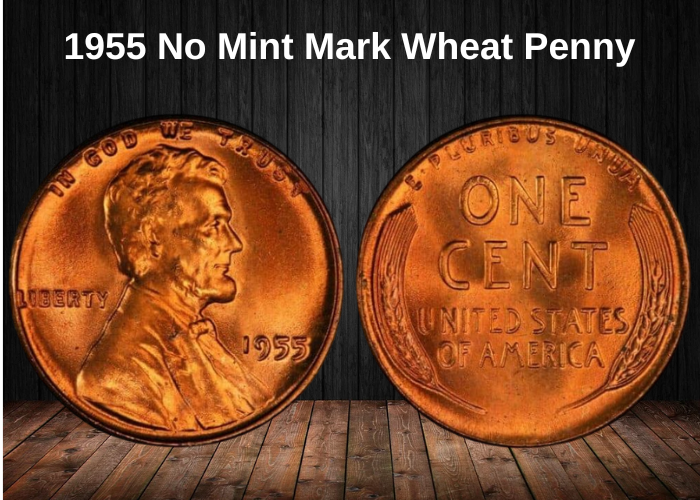
If your 1955 Wheat penny was minted in Denver, you’ll notice a small “D” mint mark just below the date on the obverse (front) of the coin.
If there’s no mint mark, your penny was struck in Philadelphia. As the original U.S. Mint facility, Philadelphia didn’t use a mint mark to distinguish its coins.
In 1955, over 33 million Wheat pennies were minted in Philadelphia. That large quantity means the coin is still relatively common today, keeping its value modest—especially for those in circulated condition, which are usually worth just a bit more than their face value.
However, uncirculated “red” coins can be much more valuable. Their price depends heavily on condition, which is assessed using a numerical grading scale from 1 to 70. Coins that have never been in circulation are known as “mint state” and are graded between MS60 and MS70.
Even a single point difference at these higher grades can have a significant impact on value. For example:
- A red 1955 penny graded MS60 is worth about $3
- At MS63, it’s valued around $9
- At MS65, it rises to about $22
The highest known grade for a 1955 no-mint-mark penny is MS67+. Only nine examples have been certified at this level so far, and PCGS (Professional Coin Grading Service) estimates their value at $2,750 each.
1955 D Wheat Penny Value
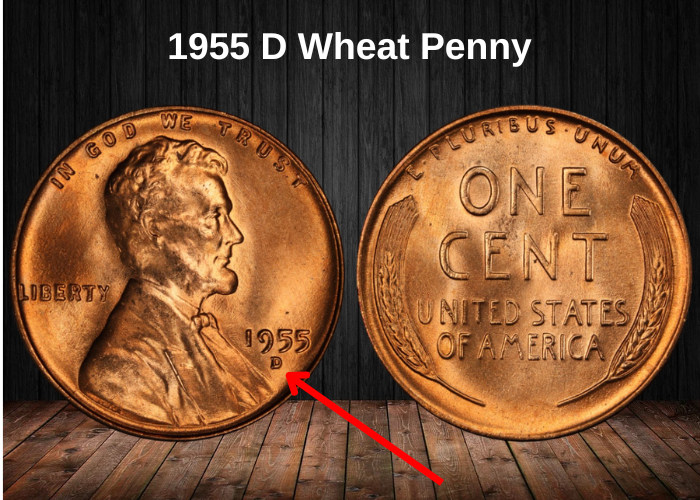
If your 1955 Wheat penny has a small “D” mint mark below the date, it was minted in Denver. A huge number of coins share this pedigree—over 563 million were struck there in 1955.
In circulated condition, these Denver pennies generally have values similar to their Philadelphia counterparts. Unless there’s an error that makes them more interesting or rare, a typical 1955 Denver penny in circulated condition will only be worth a few cents.
Even for red pennies in mint state, the price remains modest. A MS60 example can be found for about $4, while a MS65 coin (the lowest grade considered a “gem”) can be purchased for roughly $20.
The highest-grade examples of these Denver pennies, graded MS67+ by PCGS, are extremely rare. Despite the larger mintage, fewer high-quality coins exist compared to the Philadelphia versions. So far, only six coins have earned this grade, and each one is valued at $6,750.
1955 S Wheat Penny Value

If your 1955 Wheat penny has a small “S” mint mark beneath the date, it was minted in San Francisco. Just over 44 million coins were struck there that year. This number is higher than Philadelphia’s mintage, but still much lower than Denver’s.
Like the other 1955 Wheat pennies, those in circulated condition generally won’t be worth much more than face value. However, red uncirculated pennies are more sought after. For these, prices range from around $2 at MS60 to about $18 at MS65.
The finest 1955 Wheat penny, however, has an S Mint mark. The PCGS has graded one single coin at MS68, which is half a point higher than the best examples from both Denver and Philadelphia.
1955 (P) Proof Wheat Penny Value
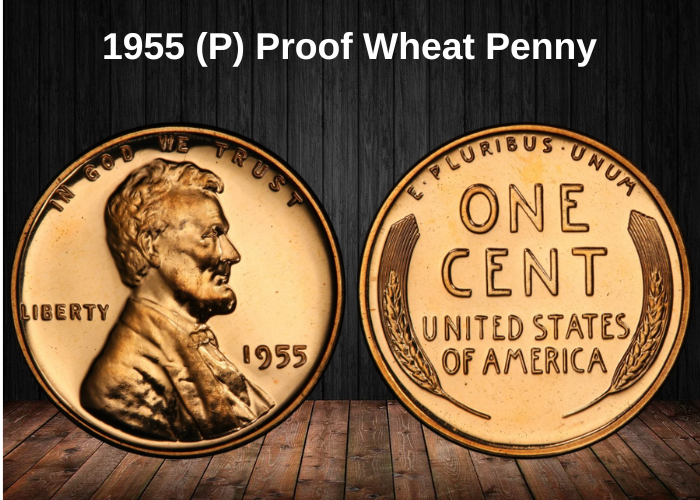
Proof coins are crafted with the highest possible quality. They are struck on specially polished planchets, and the dies used are designed to produce exceptional detail.
Initially, proofs were minted in small quantities and reserved for coin archives. However, as coin collecting gained popularity, the Mint began producing larger batches specifically for collectors.
In 1955, the Philadelphia Mint produced both regular business strike pennies and proof pennies. While the mintage of proofs was smaller, there were still plenty available, with 378,200 proof pennies struck that year.
As with other Philadelphia coins, 1955 proof pennies do not carry a mint mark.
Given their higher quality and lower production numbers, you might expect these coins to be quite valuable. However, because proofs were marketed as collector’s items and carefully stored, they are still relatively easy to find, particularly in lower grades. A 1955 proof Wheat penny graded PR60 typically costs around $10.
Among the proofs, some are designated as “cameo” or “deep cameo”. These coins feature a noticeable contrast between their glossy fields and frosted designs. A coin must have a particularly strong contrast to be classified as a deep cameo.
These special designations increase a coin’s value. A 1955 proof Wheat penny graded PR66 is worth approximately $32, but the value increases to $80 for a cameo and up to $650 for a deep cameo.
The most valuable 1955 proof Wheat penny is a deep cameo graded PR69. The PCGS currently values this rare coin at $51,000.
Rare 1955 Wheat Penny Errors List
1955 Wheat Penny Double Die Obverse
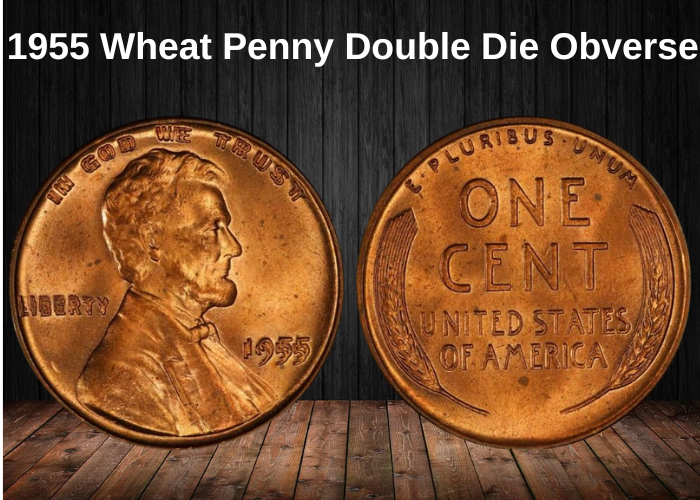
The 1955 Wheat penny featuring a double die obverse is one of the most iconic error coins ever produced. Approximately 40,000 of these were minted in a single night at the Philadelphia Mint. But how did this error come about, and what makes it so valuable?
Double die errors occur during the process of creating the die used to strike the coin’s design. The die receives the design image through repeated strikes from a hub. If the die shifts even slightly between strikes, it results in a doubled image, which is then transferred to the coins struck by that die.
On the 1955 double die obverse pennies, the doubling is most noticeable on the date and the surrounding text. There’s also some loss of detail on Lincoln’s bust, though this is less obvious.
Out of the 40,000 coins struck, around 22,000 were distributed into circulation before the error was identified. Today, only a small number of these coins exist in mint state.
In March 2019, a brown 1955 Wheat penny with this error sold for $1,500 at auction. A red penny with the same error, graded MS60, is valued by the PCGS at $3,250, while a MS65 example can fetch as much as $52,500.
The finest-known examples of the 1955 double die obverse penny are graded MS65+, and these are valued by the PCGS at a remarkable $288,000 each.
Because this error is so well-known, counterfeit versions are common. If you plan to purchase one of these valuable coins, ensure it has been independently authenticated by a reliable grading agency such as PCGS or NGC to confirm its authenticity.
1955 Wheat Penny Poor Man’s Double Die
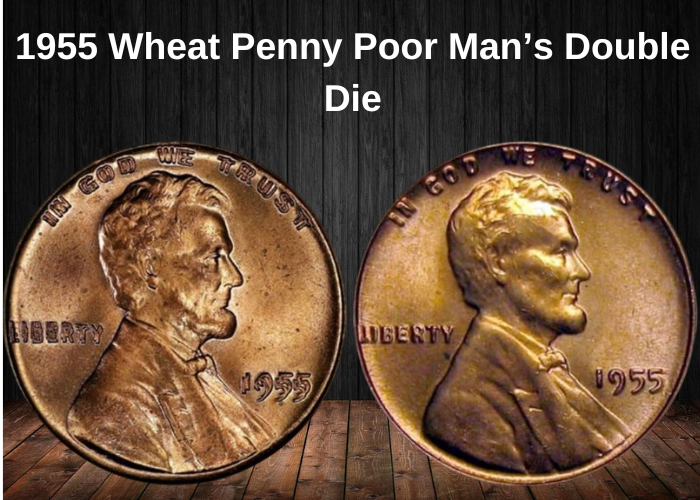
Not all double die errors are the same.
Coins referred to as the “Poor Man’s Double Die” also exhibit doubling on the obverse, but this is caused by the deterioration of the die over time, rather than an error during the die’s initial production. The die wears down with use, and this wear causes a doubled effect on the design as it continues to strike coins.
There are many more of these coins in circulation compared to the true double die obverses. The doubling is most visible on the date, much like the true error, but the cause is entirely different.
Despite their similar appearance, even high-quality examples of the Poor Man’s Double Die are generally worth only a few dollars, far less than the genuine double die obverse coins, which can be worth thousands.
Where to sell your penny?
Now that you know the value of your penny, you might be wondering where to sell it. Don’t worry: here’s a guide to some of the best online platforms where you can easily sell your coins, along with their advantages and disadvantages.
Discover the best platforms for selling coins online (pros and cons).
FAQ about the 1955 Wheat Penny
1. Why is the 1955 Wheat Penny significant in U.S. coinage history?
The 1955 Wheat Penny is significant for a few reasons:
- It is one of the last pennies to feature the Wheat reverse design, which had been in circulation since 1909. The 1955 penny was part of the final years before the U.S. Mint transitioned to the Lincoln Memorial reverse design in 1959.
- The 1955 Wheat Penny is also known for having a famous error variety: the 1955 Double Die Obverse (DDO), one of the most famous and valuable error coins in U.S. coinage history. This coin shows clear signs of a doubled die on the obverse, particularly in the “LIBERTY” and “IN GOD WE TRUST” inscriptions.
2. What is the metal composition of the 1955 Wheat Penny?
The 1955 Wheat Penny is made of:
- 95% copper
- 5% zinc
This composition remained consistent for U.S. pennies from 1909 to 1942 and again from 1944 to 1958, before the Mint switched to a copper-plated zinc alloy in the 1960s.
3. How many 1955 Wheat Pennies were minted?
The 1955 Wheat Penny had a large mintage:
- Philadelphia (no mintmark): 1,211,490,000
- Denver (D): 193,290,000
- San Francisco (S): 31,410,000
With a total mintage of around 1.44 billion pennies, the 1955 Wheat Penny is quite common, though certain varieties, such as the 1955 Double Die Obverse (DDO), are much rarer and highly collectible.
4. What is the value of a 1955 Wheat Penny today?
The value of a 1955 Wheat Penny depends on its condition and variety:
- Regular circulated coins: Typically worth around $0.05 to $0.25.
- Uncirculated coins: Coins graded MS-63 or MS-64 can be worth around $5 to $10.
- 1955 Double Die Obverse (DDO): This error variety is highly sought after, and its value varies greatly based on the grade:
- In Good condition, a DDO can be worth $500 to $800.
- In Very Fine condition, it may be worth around $1,000 to $2,000.
- In Uncirculated condition, it can sell for $10,000 or more depending on the grade.
- High-grade uncirculated coins (non-DDO) may be worth between $20 and $50 for grades MS-65 and higher.
5. What makes the 1955 Double Die Obverse so valuable?
The 1955 Double Die Obverse (DDO) is one of the most famous error coins in U.S. numismatics. It was caused by an issue with the die used to strike the coins, which was not properly aligned during the minting process. As a result, the “LIBERTY” and “IN GOD WE TRUST” inscriptions are doubled. This error is easily visible with the naked eye, especially in the letters and numbers.
The 1955 DDO is highly collectible and valuable because it is relatively rare and one of the most recognized and sought-after errors in U.S. coinage.
6. How can I identify the 1955 Double Die Obverse (DDO)?
To identify a 1955 Double Die Obverse (DDO), look for:
- Doubling on the obverse, particularly in the “LIBERTY” and “IN GOD WE TRUST” inscriptions. The doubled areas will show a distinct, blurry or ghostly image of the letters.
- The doubling is visible to the naked eye, making this one of the most famous and easiest error coins to identify.
- The date (1955) may also show signs of doubling, but the inscriptions are the most prominent feature.
If you come across a 1955 penny with noticeable doubling on the obverse, especially in the inscriptions, you may have a valuable DDO.
7. How does the 1955 Wheat Penny compare to other years in the Wheat series?
The 1955 Wheat Penny is unique because:
- It is part of the final years of the Wheat reverse design, making it an important coin for collectors of this series.
- The 1955 Double Die Obverse (DDO) error makes it stand out, and it is considered one of the most valuable coins in the Wheat series because of this variety. The DDO is one of the most famous error coins in U.S. history, giving the 1955 penny extra historical significance.
Compared to other years in the Wheat series, the 1955 penny is more valuable due to the presence of the DDO error. However, non-DDO 1955 pennies are similar in value to other common Wheat pennies from the 1950s.



















































